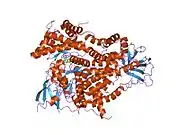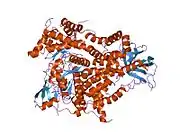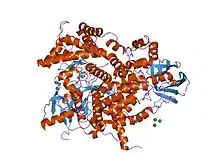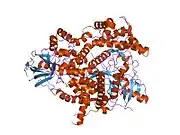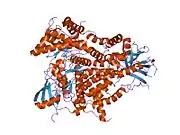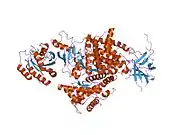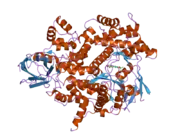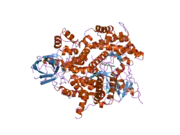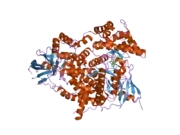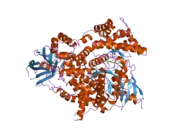Phosphatidylinositol-4,5-bisphosphate 3-kinase catalytic subunit gamma isoform is an enzyme that in humans is encoded by the PIK3CG gene.
Function
This gene encodes a protein that belongs to the pi3/pi4-kinase family of proteins. The gene product is an enzyme that phosphorylates phosphoinositides on the 3-hydroxyl group of the inositol ring. It is an important modulator of extracellular signals, including those elicited by E-cadherin-mediated cell-cell adhesion, which plays an important role in maintenance of the structural and functional integrity of epithelia. In addition to its role in promoting assembly of adherens junctions, the protein is thought to play a pivotal role in the regulation of cytotoxicity in NK cells. The gene is located in a commonly deleted segment of chromosome 7 previously identified in myeloid leukemias.[5]
Interactions
PIK3CG has been shown to interact with:
See also
References
- 1 2 3 GRCh38: Ensembl release 89: ENSG00000105851 - Ensembl, May 2017
- 1 2 3 GRCm38: Ensembl release 89: ENSMUSG00000020573 - Ensembl, May 2017
- ↑ "Human PubMed Reference:". National Center for Biotechnology Information, U.S. National Library of Medicine.
- ↑ "Mouse PubMed Reference:". National Center for Biotechnology Information, U.S. National Library of Medicine.
- ↑ "Entrez Gene: PIK3CG phosphoinositide-3-kinase, catalytic, gamma polypeptide".
- ↑ Bai RY, Jahn T, Schrem S, Munzert G, Weidner KM, Wang JY, Duyster J (August 1998). "The SH2-containing adapter protein GRB10 interacts with BCR-ABL". Oncogene. 17 (8): 941–8. doi:10.1038/sj.onc.1202024. PMID 9747873. S2CID 20866214.
- ↑ Salgia R, Sattler M, Pisick E, Li JL, Griffin JD (February 1996). "p210BCR/ABL induces formation of complexes containing focal adhesion proteins and the protooncogene product p120c-Cbl". Exp. Hematol. 24 (2): 310–3. PMID 8641358.
- ↑ Skorski T, Kanakaraj P, Nieborowska-Skorska M, Ratajczak MZ, Wen SC, Zon G, Gewirtz AM, Perussia B, Calabretta B (July 1995). "Phosphatidylinositol-3 kinase activity is regulated by BCR/ABL and is required for the growth of Philadelphia chromosome-positive cells". Blood. 86 (2): 726–36. doi:10.1182/blood.V86.2.726.bloodjournal862726. PMID 7606002.
- ↑ Rubio I, Wittig U, Meyer C, Heinze R, Kadereit D, Waldmann H, Downward J, Wetzker R (November 1999). "Farnesylation of Ras is important for the interaction with phosphoinositide 3-kinase gamma". Eur. J. Biochem. 266 (1): 70–82. doi:10.1046/j.1432-1327.1999.00815.x. PMID 10542052.
- ↑ Vanhaesebroeck B, Welham MJ, Kotani K, Stein R, Warne PH, Zvelebil MJ, Higashi K, Volinia S, Downward J, Waterfield MD (April 1997). "P110delta, a novel phosphoinositide 3-kinase in leukocytes". Proc. Natl. Acad. Sci. U.S.A. 94 (9): 4330–5. Bibcode:1997PNAS...94.4330V. doi:10.1073/pnas.94.9.4330. PMC 20722. PMID 9113989.
- ↑ Brock C, Schaefer M, Reusch HP, Czupalla C, Michalke M, Spicher K, Schultz G, Nürnberg B (January 2003). "Roles of G beta gamma in membrane recruitment and activation of p110 gamma/p101 phosphoinositide 3-kinase gamma". J. Cell Biol. 160 (1): 89–99. doi:10.1083/jcb.200210115. PMC 2172741. PMID 12507995.
Further reading
- Alloatti G, Montrucchio G, Lembo G, Hirsch E (2004). "Phosphoinositide 3-kinase gamma: kinase-dependent and -independent activities in cardiovascular function and disease". Biochem. Soc. Trans. 32 (Pt 2): 383–6. doi:10.1042/BST0320383. PMID 15046613.
- Rommel C, Camps M, Ji H (2007). "PI3K delta and PI3K gamma: partners in crime in inflammation in rheumatoid arthritis and beyond?". Nat. Rev. Immunol. 7 (3): 191–201. doi:10.1038/nri2036. PMID 17290298. S2CID 43376714.







